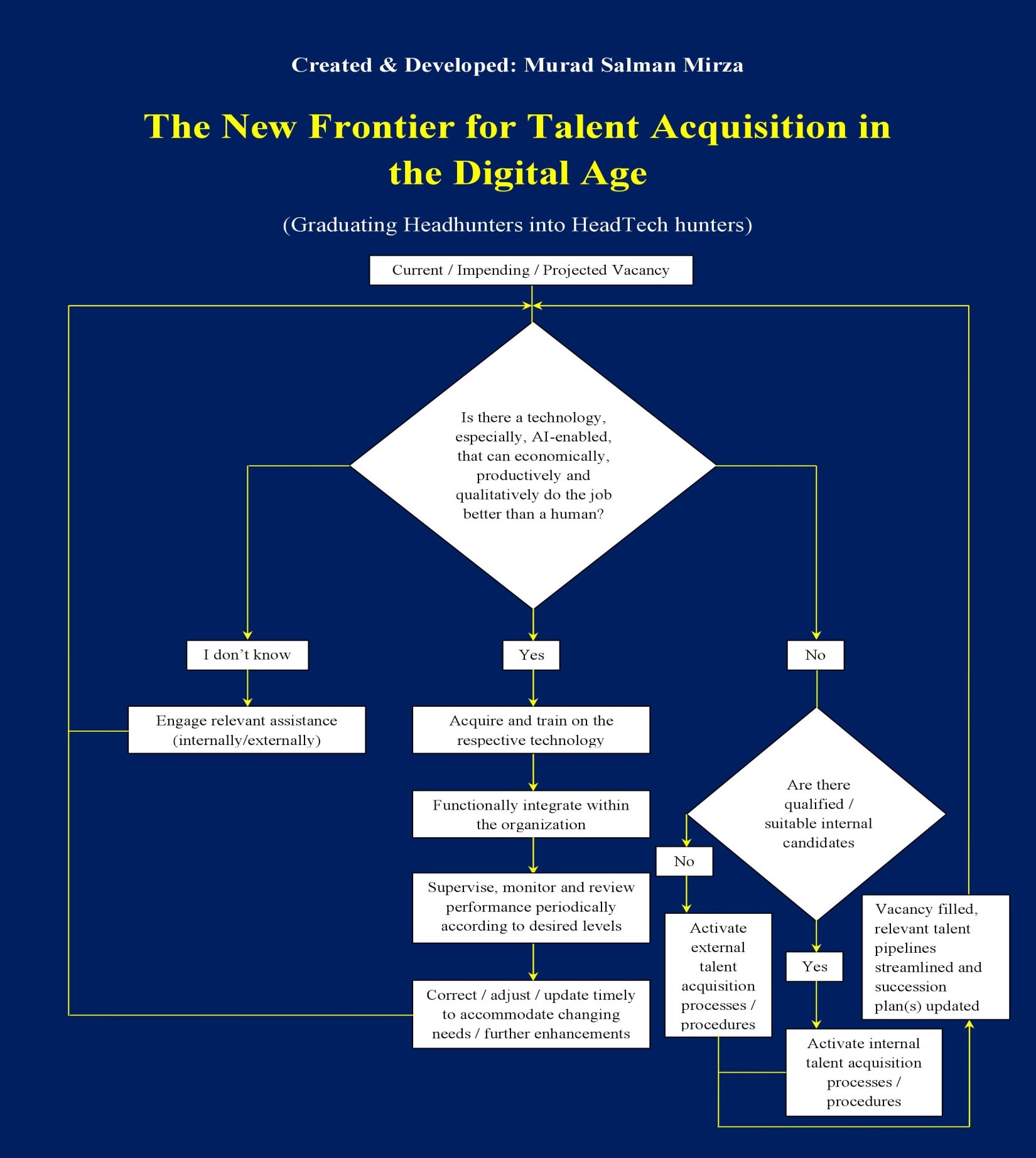Finding the right talent for the Digital Age has become increasingly critical for competitive organizations as the relevant dynamic demands keep revising the roles/skill sets that are needed to succeed in the future. The steady influx of AI-enabled entities in the workplace has been a key factor in the respective context as the notion of the ‘right talent mix’ now involves both ‘human’ and ‘non-human’ team members. Consequently, this has put significant strain on the historically cozy and secure relationship between recruiting firms, especially, in the ‘retained’ category, and their corporate clients as conventional/unconventional recruitment approaches favoring induction of ‘human talent’ are not deemed to be in optimized congruence with the organizational imperatives of higher efficiency, faster productivity, refined timeliness, seamless manufacturing/services, and consistently innovative offerings to remain relevant in the face of disruptive influences/competitors.
As a result, the recruiting firms are having a hard time distinguishing themselves significantly from their competitors in terms of facilitating the hiring of capable talent. Generally, astute networking/relationship techniques and fancy tech/graphics/analytics support are deployed to gain favor with current/potential clients to ensure steady a stream of business and the more successful ones are generally run on the principle of ‘who they know’, rather than, ‘what they know’. However, such ‘tried and tested’ methods are increasingly being upstaged with the rapid induction and deployment of AI-enabled entities that marginalize ‘human talent’ considerations due to their perceived and actual benefits.
Additionally, the technology being used/developed/foreseen within the realm of talent acquisition is poised to phase out recruiting firms/headhunters/assessment centers themselves. Examples in the respective context include, the prospect of Artificial Intelligence (AI)-enabled assistants, e.g., Alexa (Amazon), Siri (Apple), Google Assistant (Google) and Cortana (Microsoft), etc., becoming recruiting-assistants by analyzing candidate data/information on the organization’s website, Augmented Reality (AR) providing real-time interview support, e.g., interviewers wearing AR glasses that can analyze human expressions/body movements to gauge the validity/truthfulness of responses, Virtual Reality (VR) headsets that create scenarios analogous to real-life situations/challenges for a particular role/function given to candidates for gauging insights into their abilities as an alternative/replacement for time-consuming/resource-draining /expensive/immobile assessment centers, etc. This mandates a strategic rethink of how recruiting firms can remain relevant in the Digital Age by embracing/evolving into a new form of recruiting/talent acquisition paradigm that caters to both ‘human’ and ‘non-human’ workforce. Consequently, the term ‘HeadTech Hunter’, rather than, ‘Headhunter’ is proposed in the respective context to enable compatibility with the following new process of acquiring talent in the Digital Age:

The aforementioned process starts with a current/impending/projected vacancy becoming open that leads to a decision pertaining to the availability of any technology, especially, AI-enabled, that can economically, productively and qualitatively do the highlighted job better than a human. There are three paths shown as a consequence of such a decision, i.e., ‘I don’t Know’, ‘Yes’ and ‘No’.
I don’t know
This path is an acknowledgement by the HR/talent acquisition/leadership function of the organization grappling with the current/impending/projected vacancy that they don’t have the expertise to gauge whether an alternative to hiring a human exists in the market. Consequently, it prompts the designated/assigned person to seek internal/external assistance in terms of gaining a firm answer in the respective context. An example of internal support in the respective context is the IT function since they are normally the premier source for technological advancements for the organization. External examples of soliciting information include, OEMs (Original Equipment Manufacturers), vendors/resellers of relevant Tech/AI-enabled equipment, Tech/AI-themed shows/exhibitions/conferences, etc.
Yes
This path is a resolute affirmation of the existence of an effective alternative/replacement for the human talent to perform the functions of the current/impending/projected vacancy. It provides an incentive for the organizational leadership to explore/consider/invest in the technology, especially, AI-enabled, that can provide cost-effective and highly-efficient way of achieving their strategic/operational goals and gain a profound business edge over their competitors without running afoul of any applicable labor laws/rules/regulations. It entails the acquisition and training on the respective technology, especially, AI-enabled, by suitably qualified personnel who will be fewer in number and with a much higher level of technical skill set required for the conventional human-to-human engagement. It will require careful functional integration of the respective technology, especially, AI-enabled, with the applicable interfaces (human and non-human) to ensure a seamless operation.
Subsequently, it will require the timely supervision and monitoring by capable personnel to assure and ensure that the respective technology, especially, AI-enabled, is delivering on its marketed/stipulated merit. A periodic review at the senior/top management level on the efficacy of its deployment will provide additional perspectives and any corrective/preventive actions required to avoid derailment of the respective investment. This will also include close coordination/collaboration with the inventors/manufacturers to have additional relevant insights, e.g., on longevity, maintenance, durability, dependability, effectiveness, etc.
No
This path is a firm admission on the basis of available evidence that human talent is still the best option to perform the functions of the current/impending/projected vacancy. Consequently, it leads to seeking suitably-qualified candidates from within the organization in the first instance by activating the relevant internal talent acquisition processes/procedures. In case no internal candidate can meet the job specifications, the relevant external talent acquisition processes/procedures are activated to fill the respective vacancy from outside the organization. Subsequently, the pertinent talent pipelines are streamlined and succession plan(s) updated by taking prudent measures in minimizing any disturbances and associated risks.
Food for thought
The rapid intake of AI-enabled entities in the workplace is changing the very nature of progressive organizations and how they operate in terms of remaining relevant in the Digital Age. This has a considerable ripple-effect on the ecosystem that facilitates the effective achievement of organizational imperatives. Recruiting firms/headhunters are one of the primary affected parties and have to inculcate timely changes within their own way of functioning that can help them align with the evolving needs/expectations of their current/potential clients that are no longer amenable to the thought of ‘hiring/inducting’ only human talent and would prefer working with those partners that can provide a wider bandwidth of efficient/effective options for them to take astute decisions for safeguarding their future in the Digital Age. This opens the horizon for strategic collaboration/coordination between the inventors/manufactures of the AI-enabled entities and the recruiting firms, thus, ushering in the era of the HeadTech hunter…






